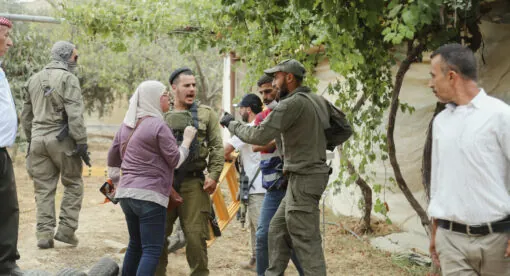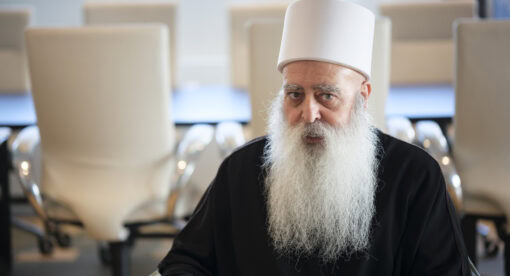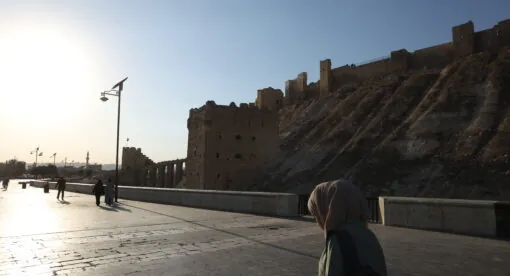The Weekly Forecast Monitor is a forward-looking assessment of geopolitical dynamics shaping our world. To get more in-depth analysis of these issues and learn more about analytical products from New Lines Institute — including simulations, training sessions, and forecast reports — contact us at [email protected] and visit https://newlinesinstitute.org/analytical-products/. Download PDF Version.
Listen to the WFM podcast here
Global Hotspots
The Global Hotspot Tracker examines the outlook for key geopolitical hotspots around the world. (Go to the Global Connectivity Tracker)
Russia/Ukraine Conflict
Summary – The Russia-Ukraine conflict is trending toward military and hybrid escalation scenarios as Ukraine continued its incursion into Russia’s Kursk region. Russia sentenced a dual Russian-American citizen to 12 years in prison for treason, while Germany issued an arrest warrant for a Ukrainian suspect in the Nord Stream gas pipeline explosion. Discussions began over a prisoner exchange between Russia and Ukraine.
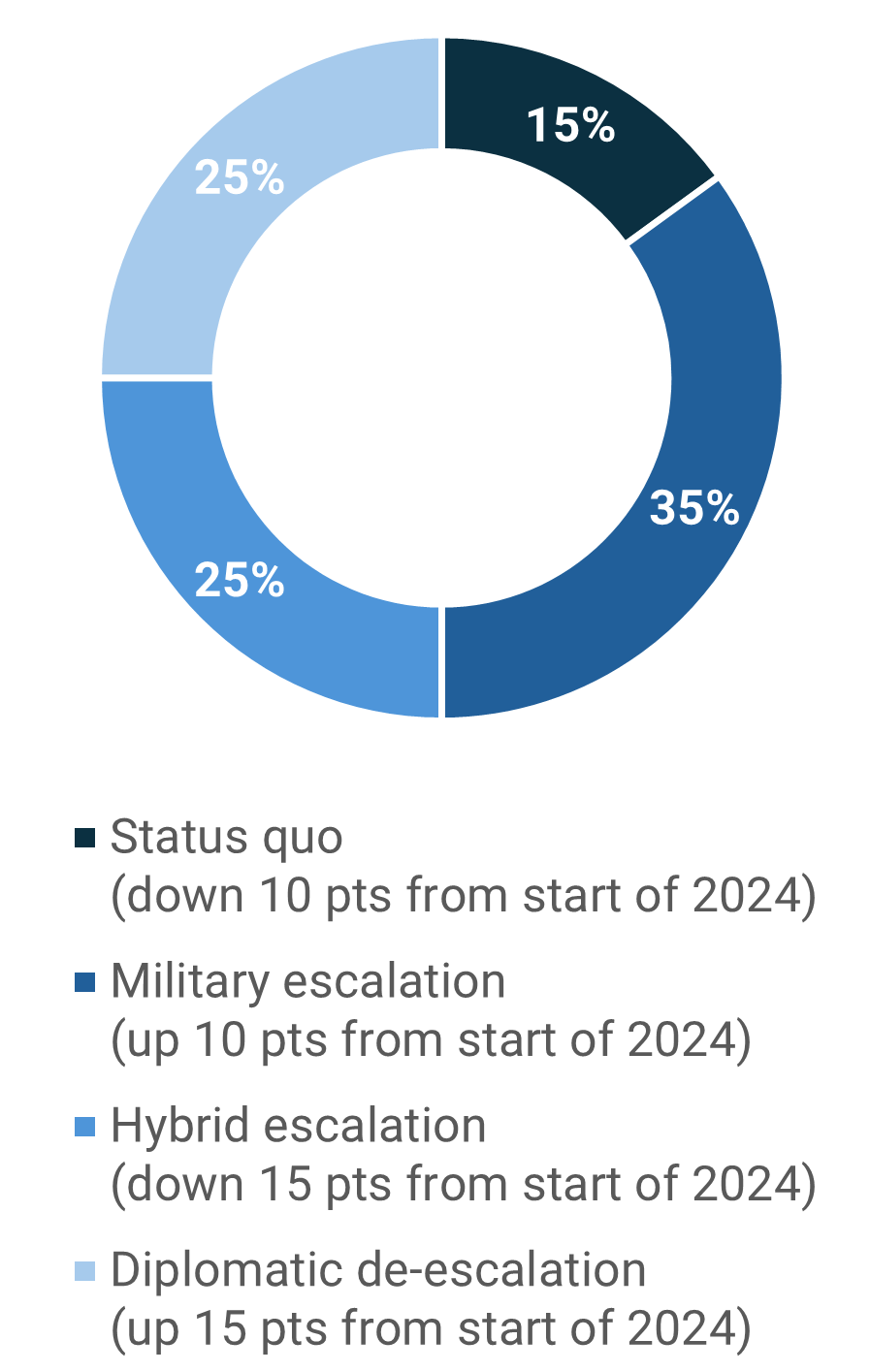
Military escalation scenario
- Ukrainian forces continued their assault on the Kursk region, claiming full control over the town of Sudzha. Ukrainian special forces captured over 100 Russian troops in a single day of fighting.
Risk level – medium - Russia continued its offensive in eastern Ukraine, reportedly taking the village of Ivanivka while stepping up attacks on Pokrovsk.
Risk level – medium - Belarus reinforced its border with Ukraine after the Belarusian Foreign Ministry claimed Ukrainian drones violated its airspace and warned that Ukraine is planning “armed provocations.”
Risk level – low/medium
Hybrid escalation scenario
- Dual Russian-American citizen Ksenia Karelina was sentenced to 12 years in prison after a Russian court found her guilty of treason for donating $51.80 to a charity in support of Ukraine.
Risk level – low/medium - Germany issued an arrest warrant for a Ukrainian man suspected of involvement in the sabotage of the Nord Stream gas pipeline. Ukraine denied involvement in the attack.
Risk level – low/medium
Diplomatic de-escalation scenario
- Ukraine and Russia began discussions over an exchange of prisoners captured by Ukrainian forces during their Kursk incursion.
Opportunity level – low
Middle East
Summary – Tensions in the Middle East trend toward military and hybrid escalation scenarios, even as peace talks resumed in Qatar. The U.S., which authorized additional weapons sales to Israel, warned that Israel’s current tactics will not lead to Hamas’ defeat as the region braces for a retaliatory attack from Iran. ISIS is reemerging as a threat in the Syrian desert despite U.S. and coalition efforts. Russian armed forces are being trained on Iranian missile systems to use against Ukraine. In Yemen, al-Houthi rebels attacked U.N. offices and are restricting the movements of aid workers.
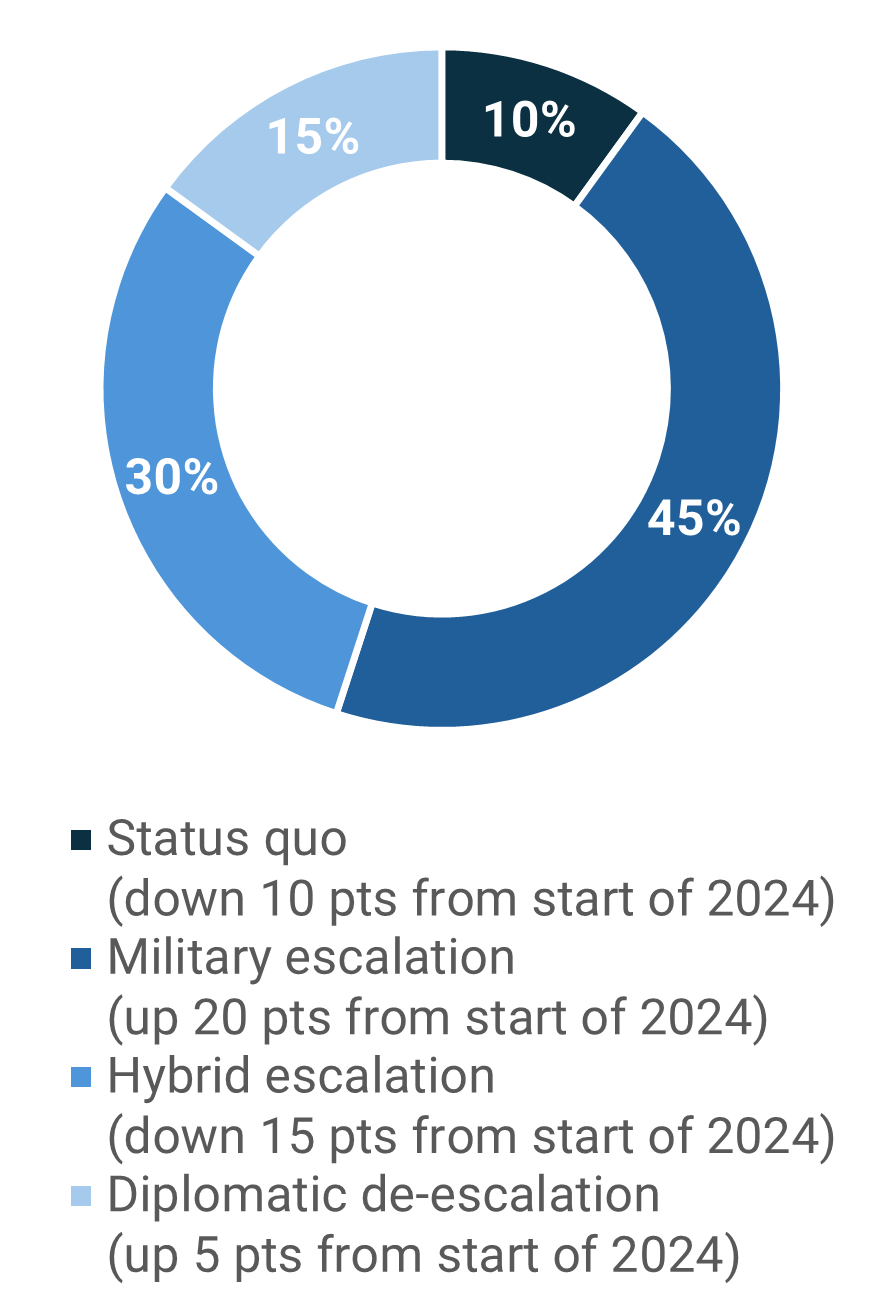
Military escalation scenario
- The U.S. authorized additional arms sales to Israel, though the Pentagon said the deliveries of F-15 jets and tank and mortar cartridges under the deal would not begin for years.
Risk level – medium - Israeli Defense Minister Yoav Gallant warned the U.S. that Iran was preparing for a large attack on Israel as the countries coordinate on Israeli defense. Israeli Foreign Minister Israel Katz said he expects France and the U.K. to attack “significant targets” in Iran as well as support Israeli defensive operations.
Risk level – medium - ISIS is re-emerging as a threat in the Syrian desert as it trains new recruits in suicide bombing techniques to target allied troops, according to U.S. and SDF troops in the region.
Risk level – medium - Iranian satellite-guided weapons are expected to be delivered to Russia to use against Ukraine, Russian armed forces are in Iran being trained on those missile systems.
Risk level – medium
Hybrid escalation scenario
- Israeli Finance Minister Bezalel Smotrich announced plans for new settlements in the West Bank.
Risk level – medium - The Houthis have begun restricting U.N. and other aid workers’ movements by requiring them to obtain permission before traveling between cities.
Risk level – low/medium
Diplomatic de-escalation scenario
- Israel added new conditions to peace negotiations with Hamas, including a demand that they oversee the Philadelphi Corridor after a cease-fire, The New York Times reported.
Opportunity level – low/medium - Hamas has stated that it will not join cease-fire talks in Qatar but may speak with mediators afterward.
Opportunity level – medium/high
U.S./China/Indo-Pacific
Summary – Tensions in the Indo-Pacific continue to trend toward a military escalation scenario, as Taiwan announced a new round of military drills. Thailand planned joint military exercises with China, while Indonesia and China discussed expanding military cooperation. Beijing said it disrupted Taiwanese spy networks on mainland China. China sent its foreign minister to Myanmar in a show of support for its government against ethnic minority rebels.
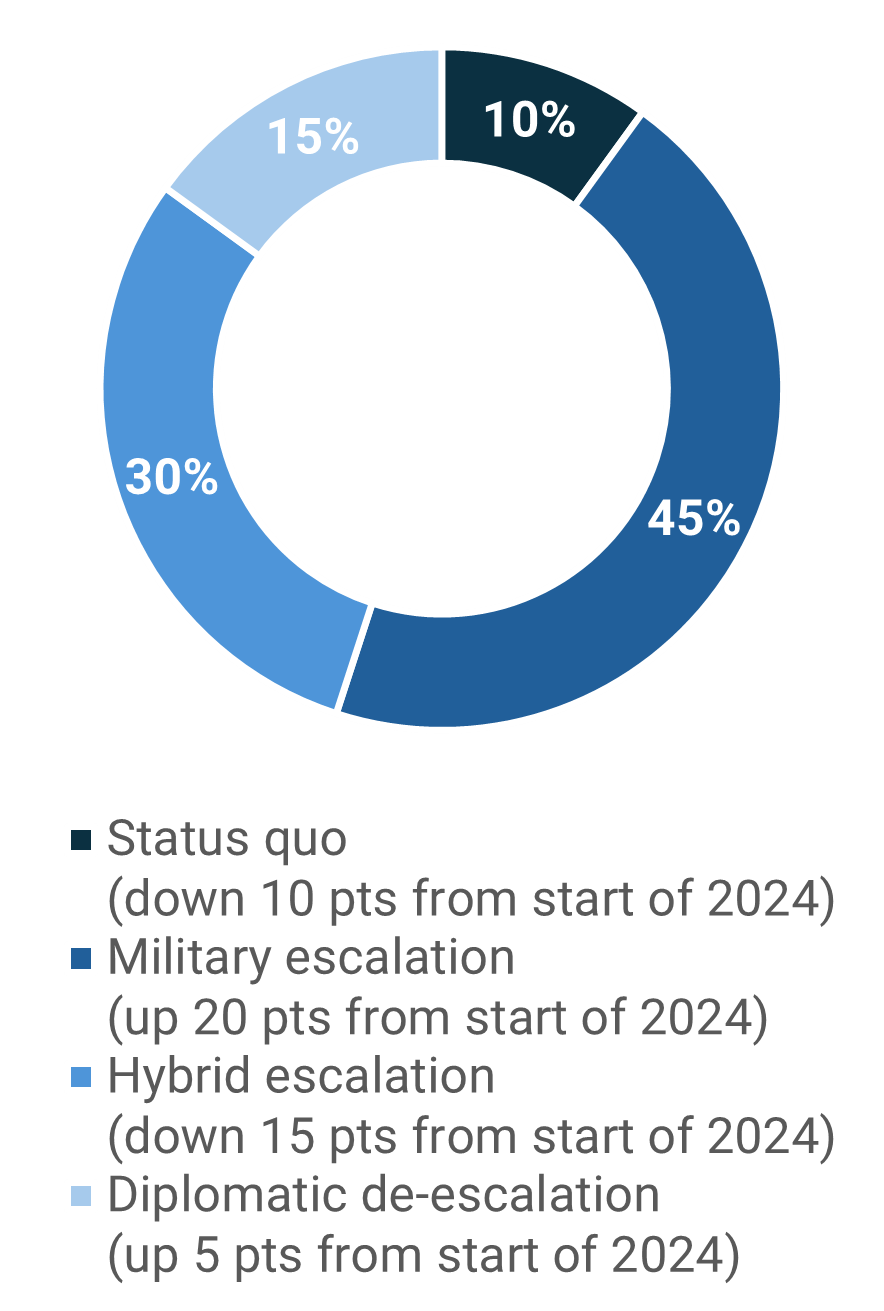
Military escalation scenario
- The People’s Liberation Army said it has developed a cheap coating for its aircraft that can provide both radar and infrared stealth capabilities.
Risk level – medium - Thailand will hold joint military drills with China involving aircraft and special operations forces as part of China’s efforts to bolster alliances with Southeast Asian nations.
Risk level – medium - Taiwan plans naval and air force live-fire drills to assess the coordinated use of new and old antiship and air-defense missiles.
Risk level – medium
Hybrid escalation scenario
- China will increase restrictions on exports of antimony, a critical mineral, in September, likely in response to U.S. restrictions on imports from China and on the export of high-technology equipment.
Risk level – medium - The Philippines condemned the Chinese air force after an incident in which Chinese planes dropped flares on a Philippine air force aircraft patrolling the Scarborough Shoal.
Risk level – medium - China’s Ministry of State Security reportedly uncovered more than 1,000 cases of Taiwanese espionage, breaking up Taiwanese spy networks in mainland China and arresting political activists.
Risk level – low/medium
Diplomatic de-escalation scenario
- The Philippines said the provisional agreement with China on resupply missions for Philippine troops on the Second Thomas Shoal would be subject to review by Manila.
Opportunity level – medium - Chinese Foreign Minister Wang Yi visited Myanmar in a show of support as rebel groups in the country advanced closer to China’s Yunnan province following the collapse of a Beijing-brokered cease-fire.
Opportunity level – low - Beijing has reasserted its denunciation of the assassination of Hamas leader Ismail Haniyeh in Tehran, calling for de-escalation in the region while supporting Iran in defending its sovereignty.
Opportunity level – low
Global Connectivity
The Global Connectivity Tracker examines the sectoral impact of geopolitical dynamics on key themes like the global energy/climate transition, trade, and technology. (Go to the Global Hotspot Tracker)
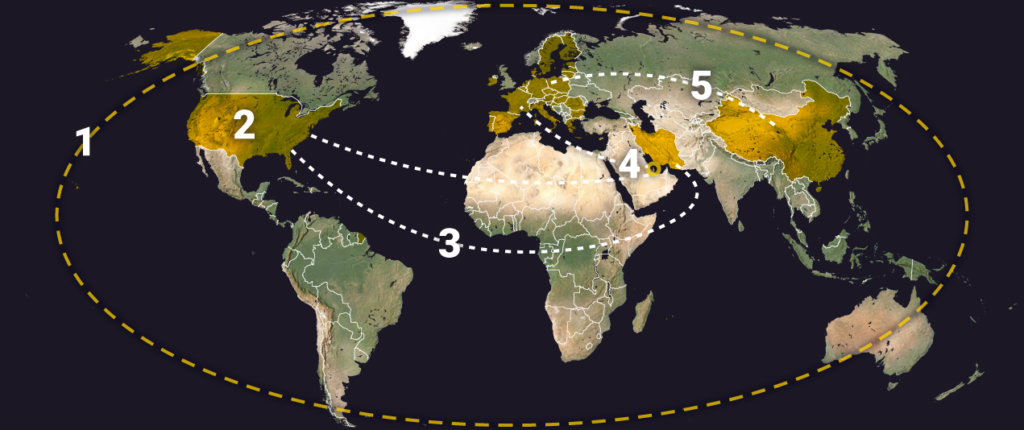
- Global: Wind Energy
What happened: National wind power targets are not sufficiently ambitious to fulfill climate change goals by 2030, a report from the independent U.K.-based energy think tank Ember concluded.
Significance/Outlook: The installation of all sources of renewable energy, including wind energy capacity, would need to triple from 2022 levels to meet commitments set out at the U.N. COP28 climate conference of holding global warming to 1.5 degrees Celsius, the report noted. Instead, wind is on pace to expand a little less than 2.5 times. Ember mentioned the United States, Russia, Japan, and South Korea as places where installed capacity falls well short of the available potential for wind energy. The growth in China’s wind energy capacity remains on pace to exceed the tripling goal, but the rest of the globe combined falls short.
Risk level – medium - U.S.: Energy/Technology
What happened: Forty percent of U.S. investments during the first year of the Inflation Reduction Act (IRA) and the CHIPS and Science Act signed by President Joe Biden in August 2022 have been postponed or canceled.
Significance/Outlook: The laws were intended to help revitalize the U.S. Rust Belt and bolster the country’s ability to compete with China in manufacturing digitization and decarbonization technologies. However, market forces, lower demand for electric vehicles (EVs), and policy uncertainty have hindered those plans. U.S. solar panel manufacturers postponed building new plants due to Chinese overproduction, while slowing U.S. demand for EVs has delayed manufacturing projects. The $400 billion IRA and CHIPS Act was supposed to have revived U.S. industry and created jobs, but 40% of the investment projects under the laws have been postponed or canceled, raising doubts about these goals.
Risk level – medium - U.S./Iran: Cyber
What happened: The FBI is investigating cyberattacks that targeted both the Democratic and Republican presidential campaigns, with Iran being the main suspect.
Significance/Outlook: Donald Trump’s campaign revealed that it had been the target of a phishing attack that successfully accessed sensitive documents that were later distributed to various news outlets, including Politico, The New York Times, and The Washington Post. Trump accused Iran of the hack, although it denies any involvement, and no official attribution has been declared by the U.S. government. In June, three members of Biden’s former campaign were also victims of phishing. The incidents are both being investigated by the FBI. Though not the first instance of alleged foreign interference in U.S. elections, it further raises the stakes for an already contentious election.
Risk level – low/medium - Qatar/U.S./EU: Critical Minerals
What happened: Qatar’s sovereign wealth fund announced a $180 million investment in TechMet, a Europe-based company specializing in the critical minerals supply chain.
Significance/Outlook: The investment will include extraction, processing, refining, and recycling of critical minerals. According to TechMet’s founder, this investment will build significant value across global critical minerals supply chains. With the funding, Qatar becomes one of its major investors, joining the U.S. Development Bank and supporting projects outside China. This is a strategic move, as Qatar is on good terms with both the U.S. and China. The U.S. realized that expanding partnerships in the critical mineral industry is key to progressing its interests globally. While these deals may reduce China’s dominance in critical minerals, it maintains a significant advantage in manufacturing advanced technology, a position that remains difficult to challenge.
Opportunity level – low/medium - China/EU: Electric Vehicles
What happened: China announced it would bring its dispute over EU tariffs on its electric vehicles to the World Trade Organization for arbitration.
Significance/Outlook: Trade tensions between China and the European Union have intensified over the EU’s imposed tariffs on Chinese electric vehicles. China has sued the EU in response to its tariff decision made in early July. The Chinese Commerce Ministry said it has resorted to this step to “safeguard the development rights and interests of the electric vehicle industry and cooperation on the global green transformation.” The EU, on the other hand, claims government subsidies give Chinese firms an unfair advantage. This dispute could escalate into a trade war that could set back the global green energy transition. The two sides have until November to resolve the issue, otherwise the provisional tariffs will be enforced for a five-year period.
Risk level – medium
Key Stats of the Week
- The International Energy Agency and the International Renewable Energy Agency estimate that to keep climate goals within targets, renewables would need to at least triple to 11,000 gigawatts by 2030.
- About 90% of that growth in renewable generation capacity would come from solar and wind generation.
- If wind generation, which had a capacity of 901 GW in 2022, triples by 2030, it would account for 19% of the global energy supply.
Source: Ember


